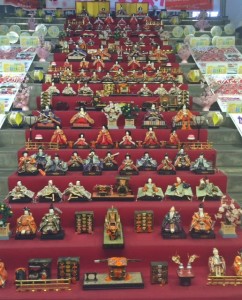The Girl’s Festival is an annual festival, celebrated on the third of March. As you can tell from its name, this festival is dedicated to little girls. The Japanese name is Hina-matsuri, the literal translation, “doll festival.”
Dolls play an important role for this special day. Originally, the dolls were made with paper. However, with the development of doll-making technology, colorful, polished dolls became popular among families with young women and girls. Now, the festival is mainly for girls and new-born babies. When a baby girl is born, the family provides her with a set of these traditional dolls as a charm against evil spirits and illness. They also symbolize marriage, so that the girl can marry and lead a happy life. These dolls are usually displayed on the first day of spring, and are put away the day after Hina-matsuri. Peach flowers are another symbol for the Girl’s Festival. Not only do peach flowers blossom during the time of the festival, but it is said that these pretty pink flowers have the ability to drive away evil spirits.
On this day, families eat specific Japanese meals and snacks. Chirashi-zushi, a type of sushi, and Hina-arare, a sweet and crunchy rice puff snack, are two popular foods for the Girl’s Festival. Ama-zake, is a traditional drink, which people also drink on other special occasions such as the New Year. The literal translation of ama-zake is sweet sake; however, there is almost no alcohol in it (less than 1%), so if the child has reached a certain age, they can enjoy it too. This drink is served hot, and has many nutrients, so it is a great way to stay healthy during the cold winter and early spring. Japan’s cultures and festivals are mostly based on the season. Hina-matsuri is no exception. Pink, green, and white are the main colors of the festival, as they represent the scenery of spring. There is also a festival for boys, which is celebrated on the 5th of May. The activities and food for this day is of course completely different from the Girl’s Festival, but regarding the aim; praying for the health and good luck of the child, it is no different.


Get Social